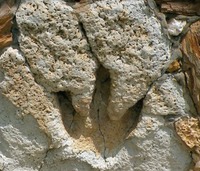 Another example of 3D data capture took place when a team from Southern Methodist University scanned prehistoric dinosaur tracks using 3D scanners out (literally) in the field.
Another example of 3D data capture took place when a team from Southern Methodist University scanned prehistoric dinosaur tracks using 3D scanners out (literally) in the field. The team used a combination of hardware (including a NextEngine HD Desktop 3D scanner with ScanStudio HD Pro software, RapidForm XOR2 Redesign and LightWave 3D) to capture the dino prints. Gigabytes of data were processed into a photorealistic digital 3D model. The result was a massive model with over 1M faces.
The teams intention was to capture this particular print before it erodes away (it’s on permanent public outdoor display) and prepare a viewable rendering. However, we who know of 3D printing may have other ideas. If you’re up to it, you might try downloading their 68Mb ZIP file containing both an OBJ and PLY format of the print. With some tweaking and fixing, it may be possible to 3D print your own dinosaur print! Download here.
Via PhysOrg and Paleo-Electronica (PDF)

